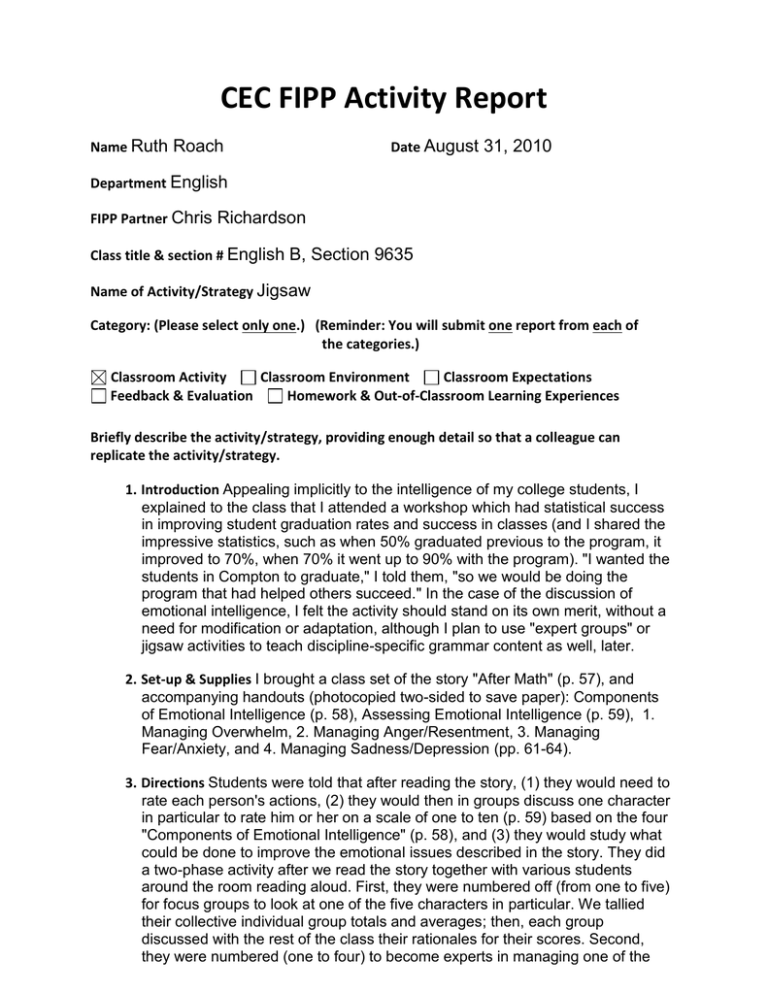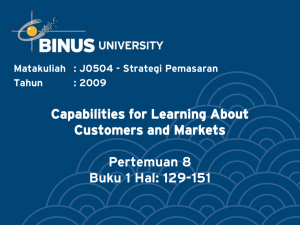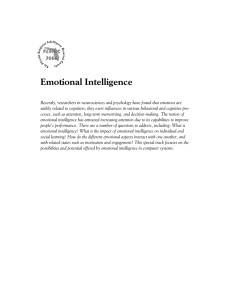Emotional Intelligence Jigsaw
advertisement

CEC FIPP Activity Report Name Ruth Roach Date August 31, 2010 Department English FIPP Partner Chris Richardson Class title & section # English B, Section 9635 Name of Activity/Strategy Jigsaw Category: (Please select only one.) (Reminder: You will submit one report from each of the categories.) Classroom Activity Classroom Environment Classroom Expectations Feedback & Evaluation Homework & Out-of-Classroom Learning Experiences Briefly describe the activity/strategy, providing enough detail so that a colleague can replicate the activity/strategy. 1. Introduction Appealing implicitly to the intelligence of my college students, I explained to the class that I attended a workshop which had statistical success in improving student graduation rates and success in classes (and I shared the impressive statistics, such as when 50% graduated previous to the program, it improved to 70%, when 70% it went up to 90% with the program). "I wanted the students in Compton to graduate," I told them, "so we would be doing the program that had helped others succeed." In the case of the discussion of emotional intelligence, I felt the activity should stand on its own merit, without a need for modification or adaptation, although I plan to use "expert groups" or jigsaw activities to teach discipline-specific grammar content as well, later. 2. Set-up & Supplies I brought a class set of the story "After Math" (p. 57), and accompanying handouts (photocopied two-sided to save paper): Components of Emotional Intelligence (p. 58), Assessing Emotional Intelligence (p. 59), 1. Managing Overwhelm, 2. Managing Anger/Resentment, 3. Managing Fear/Anxiety, and 4. Managing Sadness/Depression (pp. 61-64). 3. Directions Students were told that after reading the story, (1) they would need to rate each person's actions, (2) they would then in groups discuss one character in particular to rate him or her on a scale of one to ten (p. 59) based on the four "Components of Emotional Intelligence" (p. 58), and (3) they would study what could be done to improve the emotional issues described in the story. They did a two-phase activity after we read the story together with various students around the room reading aloud. First, they were numbered off (from one to five) for focus groups to look at one of the five characters in particular. We tallied their collective individual group totals and averages; then, each group discussed with the rest of the class their rationales for their scores. Second, they were numbered (one to four) to become experts in managing one of the four emotional intellegences (pp. 61-64), adding their own solutions to those offered if they wished. Then, I told them to assemble into groups that contained a person who had studied one of each of the four intellegences by holding up their finger with their own number--either 1, 2, 3, or 4-- and assembling themselves into groups that had #1, #2, #3, and #4 to share their understandings. Finally, they did a journal entry to discuss what they gained from the exercise. What worked well? There were several positive outcomes from this exercise. On one hand, students related to the story, stating they related to various characters or all of them at various times in their lives, and found the solutions enlightening. They were actually fairly critical of the students' misbehavior, seeing it as counterproductive; I think the activity gave them the necessary objectivity, rather than having the typical vulnerability to emotional reactions students would have if they were in the midst of a similar situation. Students also seemed motivated to assure their own success, rather than succumb to the same negative outcomes of the students in the story who dropped out or quit in various ways. Finally, they highly enjoyed connecting with their classmates through the rotations that indirectly introduced them to each other on the first day. According to their journal entries, they gained encouragement from each other in conversations-- support that they were all in this educational experience together. What would you change? There were a couple of adjustments needed. First, students should take time to rate all characters first, to provide an important initial consideration of the group of characters as a whole as to who was most to least functional.Second, the "study groups" or expert groups should not be too large. Some did not carefully study the information for their expertise and read only parts of the material when they got to that group of four and found themselves to be the only one with information. It is possible some had reading limitations or reading fears aroused by confronting an entire page of text to study on their own. Therefore, groups could be reduced to groups of two or four after students go to their four corners and then read the entire page to each other to provide reading support. Alternatively, the stakes of the assignment could be raised with a great point value or upcoming test of their knowledge because some wondered what they would do next, write about it or only discuss it, which suggested they would be more motivated to have more value attached to it. Would you use the activity/strategy again? Why or why not? Yes, I would definitely do this activity again, particularly with this group of students who are not acclimated to college life and who lack strategies to overcome emotional hindrances or barriers. Students universally commented positively on this exercise in their journal entries--how they learned much from it. Please describe any student learning and/or changes that you observed after the implementation of the activity/strategy. Students commented on their surveys that this was a great first day of class! For me, that is a positive way to start a class!


